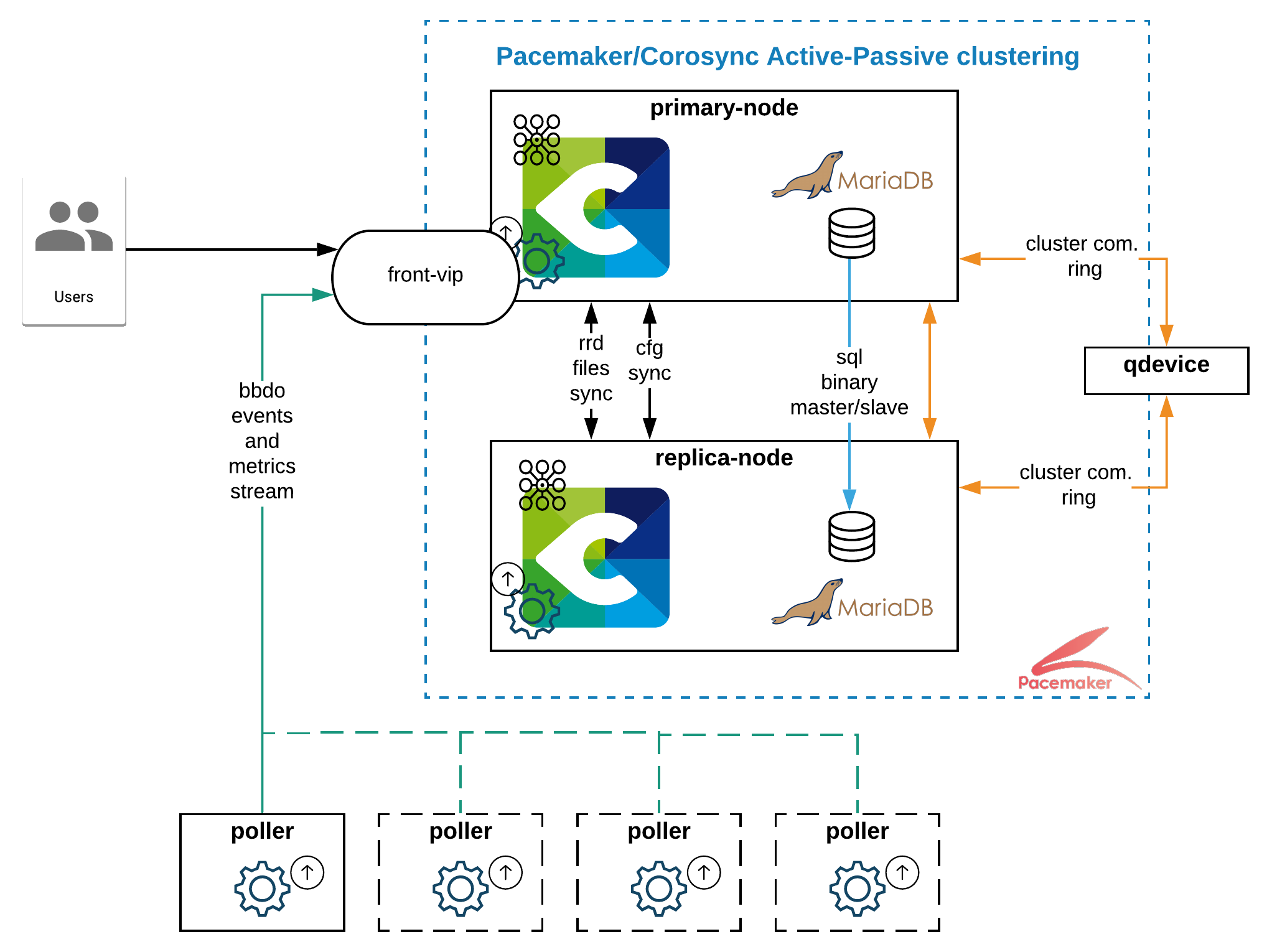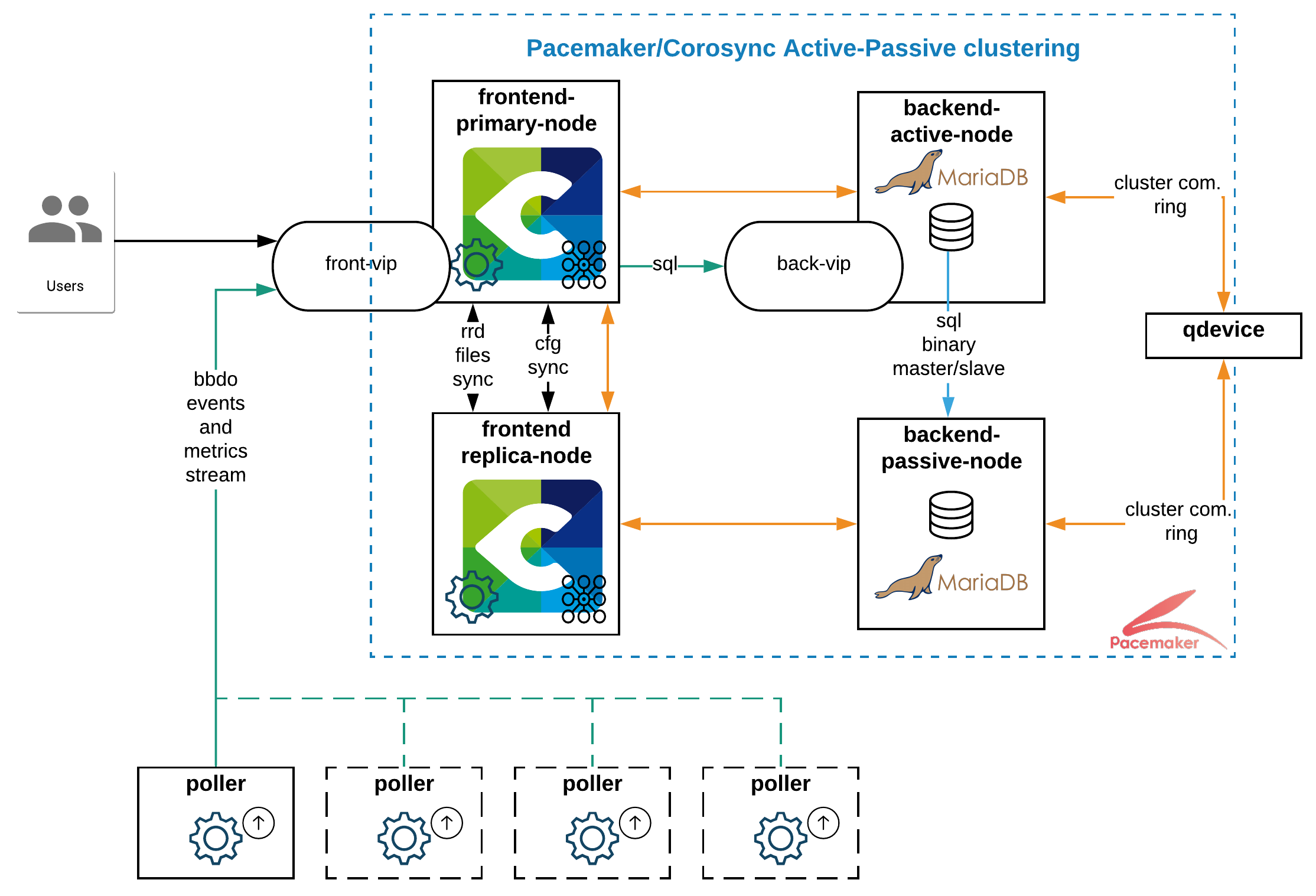Centreon-HA Overview
Introduction
Centreon-HA is the only official and supported solution to set up a highly available monitoring cluster. It includes the following:
- Documentation, mainly, to describe how to set up your Cluster on top of your Centreon solution.
- Script collection enabling safe and efficient management of Centreon related resources.
- Additionnal files extending default Centreon capabilities.
Its architecture relies on the ClusterLabs components pacemaker and corosync, allowing fault-tolerance on the following components:
- Central Server applicative daemons
- centreon-engine (scheduler)
- centreon-broker (multiplexer)
- centreon-gorgone (task manager)
- centreon-central-sync (config file replication)
- snmptrapd and centreontrapd (system and applicative trap management processes)
- Central Server third-party daemons
- php-fpm (FastCGI PHP cache)
- apache server (webserver)
- Databases
- Active/Passive binlog replication (storage)
- Hosts failures
- Virtual machines or Physical servers
Warning: If you have an IT or Business subscription, please get in touch with your Centreon Sales representative or Technical Account Manager before implementing this. Extensions need specific license files to work on both nodes smoothly.
Concepts
The solution implements three different kinds of resources:
- Multi-state resource running on both nodes with different roles.
- Clone resources, running on both primary and secondary nodes.
- Unique resources, part of a group, and running on only one node.
The cluster services are divided into two functional groups.
MariaDB functional group
The ms_mysql functional group is a multi-state resource. This resource can be in active/primary mode
on one node and in secondary/passive mode on another node.
The ms_mysql-master meta-resource is assigned to the primary database.
Centreon functional group
The centreon functional group gathers all Centreon resources to manage them.
Resources type description
All these resources are described in the table below.
| Name | Type | Description |
|---|---|---|
ms_mysql | multi-state resource | Handles mysql process and the data replication |
ms_mysql-master | location | Set MariaDB Master server rule preference |
php8 | clone service | FastCGI Process Manager service (php-fpm) |
cbd_rrd | clone service | Broker RRD service (cbd) |
centreon | group | Centreon "primitive services" group |
vip | primitive service | VIP address for centreon |
http | primitive service | Apache service (httpd24-httpd) |
gorgone | primitive service | Gorgone service (gorgoned) |
centreon_central_sync | primitive service | Files synchronization service |
cbd_central_broker | primitive service | Central Broker service (cbd-sql) |
centengine | primitive service | Centreon-Engine service (centengine) |
centreontrapd | primitive service | SNMP Traps management service (centreontrapd) |
snmptrapd | primitive service | SNMP Traps listening service (snmptrapd) |
Note: The resources of the centreon group are started one after the other in the list order.
Resources constraints
Pacemaker offers various types of constraints:
- Location: where the resource should or shouldn't run.
- Colocation: how resources behave to each other.
For example, Centreon-HA uses location constraints to specify to Pacemaker that the database process needs to be up on backend nodes but not on frontend nodes.
Regarding colocation constraints, they can ensure a Virtual IP sticks to the master nodes and/or role. Therefore Users, Pollers, and Daemons constantly interact with the primary node.
QDevice and votes
The configuration of a qdevice is mandatory to avoid split-brain and other situations nobody wants
to face in a Cluster. The server with the quorum-device role aims to obtain an absolute majority in a vote
to elect a master node or resource role.
Support
Softwares & operating systems
Centreon officialy supports Clustering on the following Products:
- Any Centreon Licensed Editions
- Centreon Map Server
And on the following Operating Systems:
- CentOS 7
- RHEL 7
Important: To install pacemaker and corosync packages on RedHat systems, servers must have access to the Red Hat Enterprise Linux High Availability licensed repository.
The only official database server Centreon supports is MariaDB.
Nevertheless, note that we validated that the whole solution can run on MySQL 8 with some modifications, only the community (or your DBAs) can help and support you in running a Cluster on top of an Oracle MySQL server.
For both MariaDB and Oracle MySQL, the replication configuration might be intrusive. We strongly discourage you setting up a cluster on a server holding other application databases, we won't support it.
Architectures
Centreon supports both 2 and 4 nodes architectures. We recommend using a two nodes architecture except if your organization requires a systematic split of front and back servers or your monitoring scope is above 5k Hosts.
Schemas below show both architecture flavor and network flows between servers. To get the complete network flow matrix, refer to the architecture dedicated installation page.
- Two-nodes-cluster
- Four-nodes-cluster
Additionnal information
Server organization
Setting up a Centreon-HA cluster might be overkill or at least not optimal when all your servers are running in the same datacenter and even more within the same rack.
In a perfect world, the primary and secondary nodes are running on different (geographical) sites, and the qdevice communicate with both sites independently. Obviously, all nodes need to communicate with each other.
Role of the Centreon central server
In the case of a highly available architecture the Centreon central cluster must not be used as a poller.
In other words, it should not monitor resources. Its monitoring ability should only be used to monitor its pollers.
If this recommendation is not followed, the centengine service would take too long to restart
and it may cause the functional centreon group to failover.
VIP and load balancing
Centreon recommends using VIP addresses.
Use a load balancer is an option but it should support custom rules to route application flows.
For example, in a four nodes setup, a load balancer can rely on:
- frontend-vip: the listening port or the apache process state to route Users and Pollers' communication toward frontend servers.
- backend-vip: the value of the "read_only" flag on both database servers to determine which one is the primary one.

